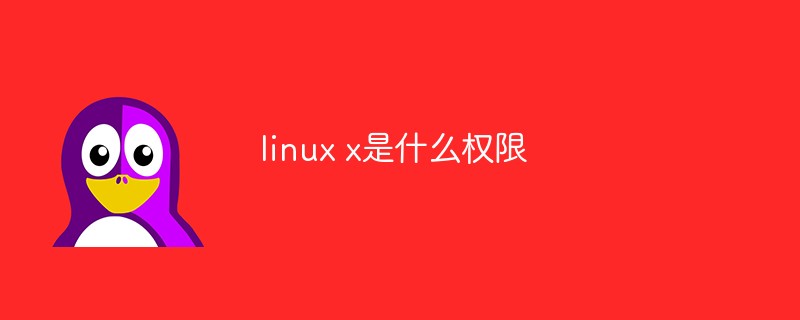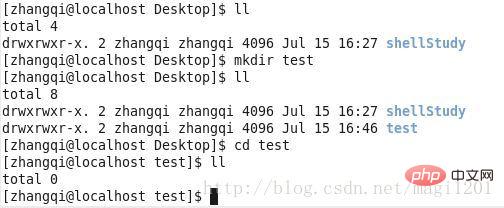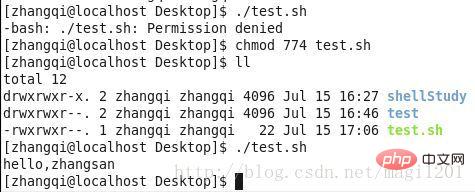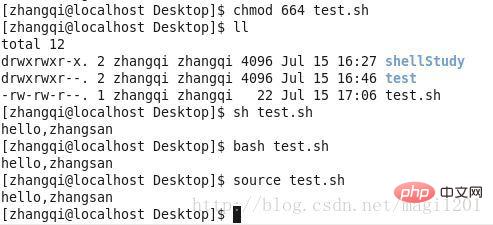What permissions are linux x
In Linux, x refers to "execution" permission. x permissions have different effects on files and directories: 1. For files, it means that the file can be run, especially shell script files, and has no effect on ordinary files; 2. For directories, it means that the user can enter the specified directory. Users granted x permissions can use the cd command to switch directories.

#The operating environment of this tutorial: CentOS 6 system, Dell G3 computer.
x refers to "execute" permission.
Linux system, there are three most common file permissions, namely read (represented by r), write (represented by w) and execute (represented by x, for executable files or directory) permissions.
x (execution) permissions have different effects on files and directories:
Function on files
| Execution permission (x) | indicates that the file has the permission to be executed by the system. In Windows systems, checking whether a file is an executable file is based on the extension (.exe, .bat, etc.), but in Linux systems, whether a file can be executed is determined by checking whether the file has x permissions. That is, as long as the file has x permissions, the file is executable. However, whether the file can run correctly depends on whether the code in the file is correct. |
Execution permission is mainly used for shell script files and has no effect on ordinary files.
The effect on the directory
| Execution permission (x) | The directory is If it cannot be run directly, granting x permissions to the directory means that the user can enter the directory. In other words, users or groups granted x permissions can use the cd command. |
Note: For a directory, if only r permission is granted, the directory cannot be used. It's very simple. For a directory with only r permissions, the user can only view the directory structure and cannot enter the directory at all (x permissions are required), let alone use it.
Note:
1. Read-only access to the directory does not allow using cd to enter the directory. You must have execution permissions to enter.
2. Only execution permissions can only enter the directory and cannot see the contents of the directory. If you want to see the file names and directory names in the directory, you need read permissions.
3. Whether a file can be deleted mainly depends on whether the directory where the file is located has write permission for the user. If the directory does not have write permission for the user, all files in the directory cannot be deleted. The file Except for the owner
4. The w permission of the directory is not set. Even if you have the w permission of a file in the directory, you cannot write to the file
The following is a detailed introduction:
1. File directory
For a file directory, the x permission is the permission to enter the directory

In the above picture, After creating the test directory, you can check that its permissions are drwxrwxr-x. Both the owner and the group have x permissions, so you can enter the test directory.
Next, we slightly modify the group permissions and only grant 664 permissions, that is, neither the owner nor the group has operation permissions. When trying to enter the test directory, permission problems will be reported

2. Ordinary files
The executable permissions of ordinary files are of little significance at present, because there is no x permission and it does not affect the file. reading and writing.

A test file test.txt is created here. You can see that the file does not have x permissions, but it does not affect file reading and writing

3. Shell script file
For shell scripts, without x permission, the script cannot be executed

It should be noted here that there are other methods for script execution, which can be executed without x permissions, as follows

Related recommendations:《Linux video tutorial》
The above is the detailed content of What permissions are linux x. For more information, please follow other related articles on the PHP Chinese website!

Hot AI Tools

Undresser.AI Undress
AI-powered app for creating realistic nude photos

AI Clothes Remover
Online AI tool for removing clothes from photos.

Undress AI Tool
Undress images for free

Clothoff.io
AI clothes remover

Video Face Swap
Swap faces in any video effortlessly with our completely free AI face swap tool!

Hot Article

Hot Tools

Notepad++7.3.1
Easy-to-use and free code editor

SublimeText3 Chinese version
Chinese version, very easy to use

Zend Studio 13.0.1
Powerful PHP integrated development environment

Dreamweaver CS6
Visual web development tools

SublimeText3 Mac version
God-level code editing software (SublimeText3)

Hot Topics
 1386
1386
 52
52
 How to use docker desktop
Apr 15, 2025 am 11:45 AM
How to use docker desktop
Apr 15, 2025 am 11:45 AM
How to use Docker Desktop? Docker Desktop is a tool for running Docker containers on local machines. The steps to use include: 1. Install Docker Desktop; 2. Start Docker Desktop; 3. Create Docker image (using Dockerfile); 4. Build Docker image (using docker build); 5. Run Docker container (using docker run).
 Difference between centos and ubuntu
Apr 14, 2025 pm 09:09 PM
Difference between centos and ubuntu
Apr 14, 2025 pm 09:09 PM
The key differences between CentOS and Ubuntu are: origin (CentOS originates from Red Hat, for enterprises; Ubuntu originates from Debian, for individuals), package management (CentOS uses yum, focusing on stability; Ubuntu uses apt, for high update frequency), support cycle (CentOS provides 10 years of support, Ubuntu provides 5 years of LTS support), community support (CentOS focuses on stability, Ubuntu provides a wide range of tutorials and documents), uses (CentOS is biased towards servers, Ubuntu is suitable for servers and desktops), other differences include installation simplicity (CentOS is thin)
 What to do if the docker image fails
Apr 15, 2025 am 11:21 AM
What to do if the docker image fails
Apr 15, 2025 am 11:21 AM
Troubleshooting steps for failed Docker image build: Check Dockerfile syntax and dependency version. Check if the build context contains the required source code and dependencies. View the build log for error details. Use the --target option to build a hierarchical phase to identify failure points. Make sure to use the latest version of Docker engine. Build the image with --t [image-name]:debug mode to debug the problem. Check disk space and make sure it is sufficient. Disable SELinux to prevent interference with the build process. Ask community platforms for help, provide Dockerfiles and build log descriptions for more specific suggestions.
 How to view the docker process
Apr 15, 2025 am 11:48 AM
How to view the docker process
Apr 15, 2025 am 11:48 AM
Docker process viewing method: 1. Docker CLI command: docker ps; 2. Systemd CLI command: systemctl status docker; 3. Docker Compose CLI command: docker-compose ps; 4. Process Explorer (Windows); 5. /proc directory (Linux).
 What computer configuration is required for vscode
Apr 15, 2025 pm 09:48 PM
What computer configuration is required for vscode
Apr 15, 2025 pm 09:48 PM
VS Code system requirements: Operating system: Windows 10 and above, macOS 10.12 and above, Linux distribution processor: minimum 1.6 GHz, recommended 2.0 GHz and above memory: minimum 512 MB, recommended 4 GB and above storage space: minimum 250 MB, recommended 1 GB and above other requirements: stable network connection, Xorg/Wayland (Linux)
 Detailed explanation of docker principle
Apr 14, 2025 pm 11:57 PM
Detailed explanation of docker principle
Apr 14, 2025 pm 11:57 PM
Docker uses Linux kernel features to provide an efficient and isolated application running environment. Its working principle is as follows: 1. The mirror is used as a read-only template, which contains everything you need to run the application; 2. The Union File System (UnionFS) stacks multiple file systems, only storing the differences, saving space and speeding up; 3. The daemon manages the mirrors and containers, and the client uses them for interaction; 4. Namespaces and cgroups implement container isolation and resource limitations; 5. Multiple network modes support container interconnection. Only by understanding these core concepts can you better utilize Docker.
 What is vscode What is vscode for?
Apr 15, 2025 pm 06:45 PM
What is vscode What is vscode for?
Apr 15, 2025 pm 06:45 PM
VS Code is the full name Visual Studio Code, which is a free and open source cross-platform code editor and development environment developed by Microsoft. It supports a wide range of programming languages and provides syntax highlighting, code automatic completion, code snippets and smart prompts to improve development efficiency. Through a rich extension ecosystem, users can add extensions to specific needs and languages, such as debuggers, code formatting tools, and Git integrations. VS Code also includes an intuitive debugger that helps quickly find and resolve bugs in your code.
 vscode cannot install extension
Apr 15, 2025 pm 07:18 PM
vscode cannot install extension
Apr 15, 2025 pm 07:18 PM
The reasons for the installation of VS Code extensions may be: network instability, insufficient permissions, system compatibility issues, VS Code version is too old, antivirus software or firewall interference. By checking network connections, permissions, log files, updating VS Code, disabling security software, and restarting VS Code or computers, you can gradually troubleshoot and resolve issues.




